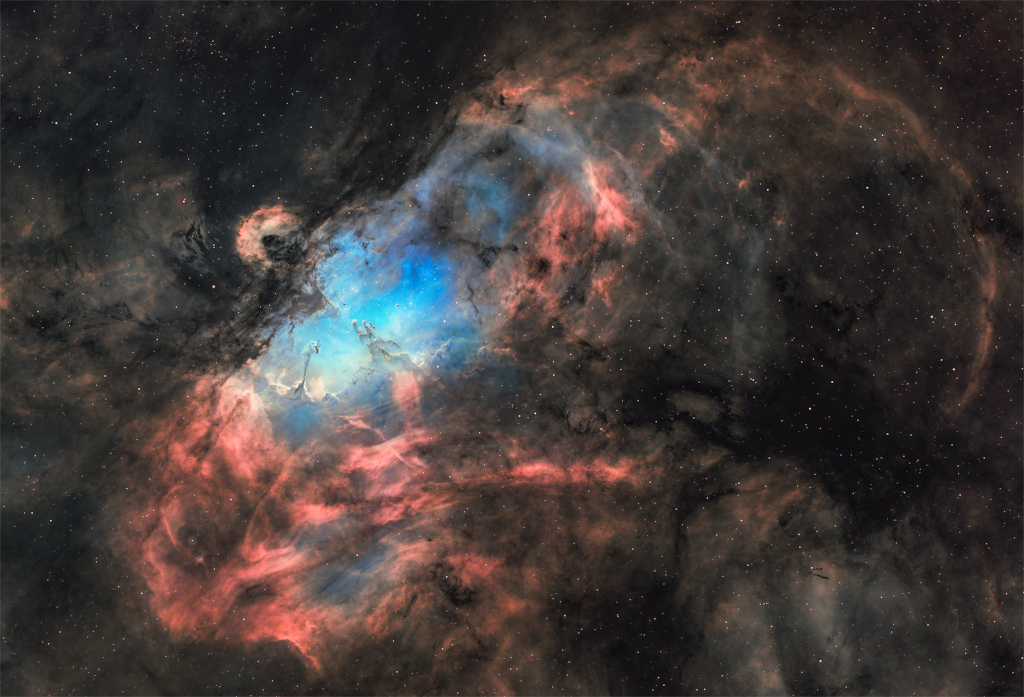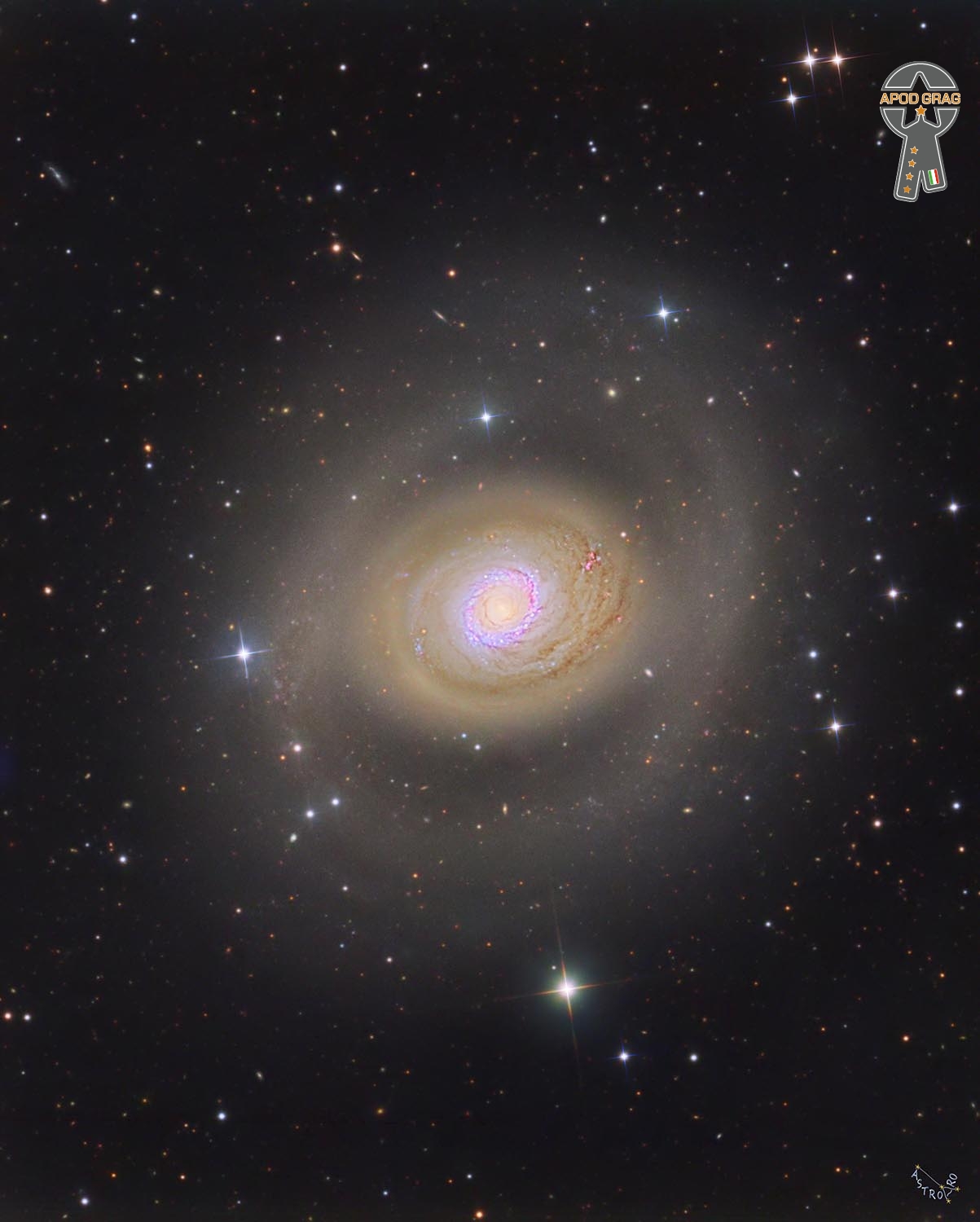Blog
Between October 2019 and February 2020 the brightness of the star Betelgeuse has dropped by more than a factor of three. New observations by the NASA/ESA Hubble Space Telescope and the robotic STELLA telescope of the Leibniz Institute for Astrophysics Potsdam (AIP) now provide an explanation for the phenomenon.
Thanks to new observational data obtained with the Hubble Space Telescope, an international team has now identified a dust cloud as the probable cause of the dimming: Scientists believe that the star unleashed superhot plasma from an upwelling of a large convection cell on the star’s surface, similar to rising hot bubbles in boiling water, only many hundred times the size of our Sun. The material then passed through the hot atmosphere to the colder outer layers of the star. There it cooled down and the resulting huge dust cloud blocked the light from about a quarter of the star’s surface, beginning in late 2019. By April 2020, the star had returned to its normal brightness.
The Hubble observations are part of a three-year Hubble study to monitor variations in the star’s outer atmosphere. The timeline that has been produced since then provided important new clues to the mechanism behind the dimming. Hubble observed the layers above the star’s surface, which are so hot that they emit mostly in the ultraviolet region of the spectrum.

Mulgrew Miller (August 13, 1955 – May 29, 2013 Greenwood, MS) was an American jazz pianist, composer, and educator. As a child he played in churches and was influenced on piano by Ramsey Lewis and then Oscar Peterson. Aspects of their styles remained in his playing, but he added the greater harmonic freedom of McCoy Tyner and others in developing as a hard bop player and then in creating his own style, which influenced others from the 1980s on.
After leaving university he was pianist with the Duke Ellington Orchestra for three years, then accompanied vocalist Betty Carter. Three-year stints with trumpeter Woody Shaw and with drummer Art Blakey‘s high-profile Jazz Messengers followed, by the end of which Miller had formed his own bands and begun recording under his own name. He was then part of drummer Tony Williams‘ quintet from its foundation, while continuing to play and record with numerous other leaders, mostly in small groups. Miller was Director of Jazz Studies at William Paterson University from 2005, and continued to play and tour internationally with other high-profile figures in the music until his death from a stroke at the age of 57.
more...Joe Puma (August 13, 1927 – May 31, 2000) was an American jazz guitarist.
Puma was born in the Bronx, New York. His first professional experience came with Joe Roland in 1949–50. He played in the band led by Cy Coleman. He acted as a session musician for many jazz musicians during the 1950s, including Louie Bellson, Artie Shaw‘s Gramercy Five, Eddie Bert, Herbie Mann, Mat Mathews, Chris Connor, and Paul Quinichette, Lee Konitz, and Dick Hyman; he also recorded extensively as a leader at this time. In the 1960s, he worked with Morgana King, Bobby Hackett, Gary Burton, and Carmen McRae, and between 1972 and 1977 he and Chuck Wayne led an ensemble. He continued to perform and teach into the late 1990s.
more...Sir George Albert Shearing, OBE (13 August 1919 – 14 February 2011) was a British jazz pianist who for many years led a popular jazz group that recorded for Discovery Records, MGM Records and Capitol Records. Shearing was the composer of over 300 titles, including the jazz standards “Lullaby of Birdland” and “Conception“, and had multiple albums on the Billboard charts during the 1950s, 1960s, 1980s and 1990s. He died of heart failure in New York City, at the age of 91. Born in Battersea, London, Shearing was the youngest of nine children. He was born blind to working-class parents: his father delivered coal and his mother cleaned trains in the evening. He started to learn piano at the age of three and began formal training at Linden Lodge School for the Blind, where he spent four years.
more...Anna Mae Winburn (née Darden; August 13, 1913 – September 30, 1999) was an influential American vocalist and jazz bandleader who flourished beginning in the mid-1930s. An African American, she is best known for having directed the International Sweethearts of Rhythm, an all-female big band that was perhaps one of the few – and one of the most – racially integrated dance-bands of the swing era.
Her first known publicized performance was singing with the studio band of Radio WOWO, Fort Wayne. She worked at various clubs in Indiana, including the Chateau Lido in Indianapolis (where she appeared under the pseudonym Anita Door).
more...“Big Chief” Russell Moore (August 13, 1912 – December 15, 1983) was an American jazz trombonist. Moore, a Pima tribe member, grew up on a Native American reservation before moving to Chicago and then Los Angeles where he learned to play various instruments eventually settling on trombone. Throughout his career, Moore worked with an array of artists including Frank Sinatra, Lionel Hampton, Alberta Hunter and Pee Wee Russell as well as recording under his own name. He is best remembered for his work as a member of Louis Armstrong’s band.
Moore was born in Gila Crossing, Arizona inside the Gila River Indian Community reservation in 1912 and belonged to the Pima tribe. He was one of five children born to mother Amy Bending Moore and father José Newton Moore. Musical performances were important to community life on the reservation particularly due to the inaccessibility of record players and radios. Moore’s exposure to music from local school bands as well as traditional Pima music sparked an interest in music from a young age.
more...A star cluster around 2 million years young surrounded by natal clouds of dust and glowing gas, Messier 16 (M16) is also known as The Eagle Nebula. This beautifully detailed image of the region adopts the colorful Hubble palette and includes cosmic sculptures made famous in Hubble Space Telescope close-ups of the starforming complex. Described as elephant trunks or Pillars of Creation, dense, dusty columns rising near the center are light-years in length but are gravitationally contracting to form stars. Energetic radiation from the cluster stars erodes material near the tips, eventually exposing the embedded new stars. Extending from the ridge of bright emission left of center is another dusty starforming column known as the Fairy of Eagle Nebula. M16 lies about 7,000 light-years away, an easy target for binoculars or small telescopes in a nebula rich part of the sky toward the split constellation Serpens Cauda(the tail of the snake). As framed, this telescopic portrait of the Eagle Nebula is about 70 light-years across.

Patrick Bruce Metheny (/məˈθiːni/ mə-THEE-nee; born August 12, 1954) is an American jazz guitarist and composer.
He is the leader of the Pat Metheny Group and is also involved in duets, solo works, and other side projects. His style incorporates elements of progressive and contemporary jazz, latin jazz, and jazz fusion. Metheny has three gold albums and 20 Grammy Awards and is the only person to win Grammys in 10 categories. He is the younger brother of jazz flugelhornist Mike Metheny.
Metheny was born in Lee’s Summit, Missouri. His father Dave played trumpet, his mother Lois sang, and his maternal grandfather Delmar was a professional trumpeter. Metheny’s first instrument was trumpet, which he was taught by his brother, Mike. His brother, father, and grandfather played trios together at home. His parents were fans of Glenn Miller and swing music. They took Metheny to concerts to hear Clark Terry and Doc Severinsen, but they had little respect for guitar. Metheny’s interest in guitar increased around 1964 when he saw The Beatles perform on TV. For his 12th birthday, his parents allowed him to buy a guitar, which was a Gibson ES-140 3/4.
more...
Joseph Charles Jones (August 12, 1926 – November 27, 2005) was an American R&B singer, songwriter and arranger, who was born in New Orleans, Louisiana, United States. Jones is also generally credited with discovering the Dixie Cups. He also worked with B.B. King. As a singer, Jones had his biggest hit in the form of the Top Five 1960 R&B hit “You Talk Too Much“, which also reached No. 3 on the Billboard Hot 100 chart.
Jones served in the U.S. Navy, where he played piano in a band, before studying music at the Juilliard Conservatory of Music. He formed a band, Joe Jones and his Atomic Rebops, in the late 1940s; band members played on Roy Brown‘s 1947 hit “Good Rocking Tonight“. He was expelled from the New Orleans local chapter of the American Federation of Musicians for attempting to set up a rival organization but was later reinstated.
Jones became a valet, then pianist and arranger for B.B. King. He recorded his first solo single, “Adam Bit the Apple”, for Capitol Records in 1954. He also discovered Shirley and Lee, with whom he worked as their pianist, and whose recording of “Let the Good Times Roll” became a hit in 1956. In 1960, a re-recording of a song he had first recorded in 1958 for Roulette Records, “You Talk Too Much,” became a national success, but his subsequent releases were less successful.
more...Harold “Doc” West (August 12, 1915, Wolford, North Dakota, United States – May 4, 1951, Cleveland, Ohio, United States) was an American jazz drummer.
West learned to play piano and cello as a child before switching to drums. In the 1930s he played in Chicago with Tiny Parham, Erskine Tate, and Roy Eldridge(1937–38). Late in the 1930s he filled in for Chick Webb when Webb was unable to lead his own orchestra. Early in the 1940s he played with Hot Lips Page, and played on the early bebop scene at Minton’s Playhouse in New York City with Dizzy Gillespie, Charlie Parker, Tiny Grimes, and Don Byas. He played with Oscar Pettiford in 1944 and stood in for Jo Jones occasionally in Count Basie‘s orchestra.
West appears on recordings from Slam Stewart, Leo Watson, Wardell Gray, Billie Holiday, Erroll Garner, Big Joe Turner, and Jay McShann. He died in 1951 while on tour with Roy Eldridge.
He was married to Florence West (deceased); they had one daughter Alita West-Kelly born December 6, 1949 (deceased 2011).
more...Percy Mayfield (August 12, 1920 – August 11, 1984) was an American Rhythm and blues singer with a smooth vocal style. He also was a songwriter, known for the songs “Please Send Me Someone to Love” and “Hit the Road Jack“, the latter being a song first recorded by Ray Charles.
Mayfield was born in Minden, Louisiana, the seat of Webster Parish, in the northwestern part of the state. As a youth, he had a talent for poetry, which led him to songwriting and singing. He began his performing career in Texas and then moved to Los Angeles in 1942, but without success as a singer until 1947, when a small record label, Swing Time Records, signed him to record his song “Two Years of Torture,” with a band that included the saxophonist Maxwell Davis, the guitarist Chuck Norris, and the pianist Willard McDaniel. The record sold steadily over the next few years, prompting Art Rupe to sign Mayfield to his label, Specialty Records, in 1950.
more...Rumba – it’s sung by French Gypsies, which is where the Gypsy Kings come in, there’s a whole Rumba Catalana scene, and there are tons of groups I’d probably know more about if I had grown up in Spain. Weirdly, Rumba is one of the hardest Palos to define in flamenco. Or maybe it’s the easiest. Either way, Rumba encompasses all sorts of stuff in flamenco, and in a way it’s the basket into which we throw everything that is otherwise impossible to categorize. It’s also the closest thing flamenco has to pop music. The easy answer is that Rumba is another Palo in flamenco, it’s in 4/4 time, and it generally has an accent on the 2+ (or you can think of it as being a 4/4 meter that’s subdivided into 3+3+2). And that’s it! It can be fast, slow or in between, it can be in any key you can think of and the lyrics can be about anything. It’s generally recognized as one of the Cantes de Ida y Vuelta, which are the songs the sailors brought back from the New World when they went off to discover and colonize the Americas.
more...Messier 94 (also known as NGC 4736) is a spiral galaxy in the mid-northern constellation Canes Venatici. It was discovered by Pierre Méchainin 1781, and catalogued by Charles Messier two days later. Although some references describe M94 as a barred spiral galaxy, the “bar” structure appears to be more oval-shaped. The galaxy has two ring structures.
M94 is classified as having a low ionization nuclear emission region (LINER) nucleus. LINERs in general are characterized by optical spectra that reveal that ionized gas is present but the gas is only weakly ionized (i.e. the atoms are missing relatively few electrons).

Jesse Alexandria Stacy (August 11, 1904 – January 1, 1995) was an American jazz pianist who gained prominence during the swing era. He is perhaps best known for his years with the Benny Goodman band during the late 1930s, particularly his performance at Goodman’s Carnegie Hall concert in 1938.
Stacy was born in Bird’s Point, Missouri, United States, a small town across the Mississippi River from Cairo, Illinois. His first piano teacher was Mabel Irene Bailey, who played piano for silent movies. In 1918 Stacy moved to Cape Girardeau, Missouri. He received his only formal music training with Clyde Brandt, a professor of piano and violin at Southeast Missouri State Teachers College (Southeast Missouri State University)[3] while sweeping at Clark’s Music Store.
more...August 11 1929 Kalighat, Calcutta; January 19 1992 Kolkata West Bengal
Manabendra Mukhopadhyay was an Indian singer and music composer in Bengali films. Coming to limelight in the early 1950s Manabendra was an innovative and stylish singer who had a strong foundation in Indian classical music. With his distinctive voice, Manabendra was an instant hit with the audience. demonstrating great talent also as a composer, using the lyrics and melody of a song with good effect. At that time Bengali modern song world had the presence of some outstanding performers like Dhananjay Bhattacharya, Manna Dey, Satinath Mukherjee, Akhilbandhu Ghosh, Hemanta Mukhopadhyay to name a few.
It is considered that during the 1950s, 1960s and 1970s the Bengali modern songs reached their peak of excellence and that period is usually called the “Golden age of Bengali Adhunik Songs”. At that time Bengal had a unique mix of singers which inspired composers and lyricists to create innumerable treasure of creative music. Each singer had his own inimitable style and compositions were made to match their individual ability. Bengali non-film modern songs were in fact was as popular, if not more, than film songs which also reached a level of popularity in the 1950s and 1960s.
more...More Posts
- World Music with Bakalina Velika
- Daily Roots with Joe Cocker
- The Cosmos with NGC 5128
- Freddie Waits Day
- Jim Keltner Day
- Connie Kay Day
- World Music with Saida Karoli
- Daily Roots with the Stingers
- Community Band performing Arbor Day Celebration
- Happy Arbor Day 2019
- The Cosmos with NGC 4993
- Lakshminarayana Shankar Day
- Teddy Edwards Day
- Johnny Shines Day
- World Music with Manitas de Plata y Jose Reyes
- Daily Roots with Bongo Man Byfield
- The Cosmos with M8
- Vassar Clements Day
- Albert King Day
- Ella Fitzgerald Day